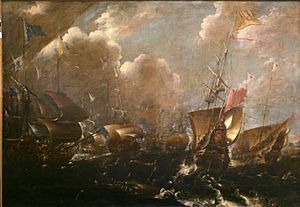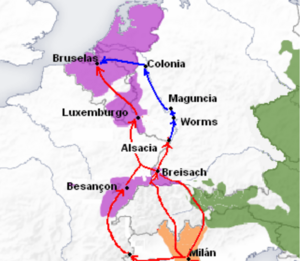Battle of Getaria facts for kids
Quick facts for kids Battle of Getaria |
|||||||
|---|---|---|---|---|---|---|---|
| Part of Franco-Spanish War (1635–59) | |||||||
 Battle of Getaria, by Andries van Eertvelt |
|||||||
|
|||||||
| Belligerents | |||||||
| Commanders and leaders | |||||||
| Strength | |||||||
| 27 warships 7 fireships, 5,000 men |
12-14 galleons , 2 Dunkirk privateers, 3-14 frigates, ; 4,000-7,000 men | ||||||
| Casualties and losses | |||||||
| No ships lost, 40 dead | All ships destroyed, except one; 3,000-4,000 dead | ||||||
The Battle of Getaria happened on August 22, 1638, near Getaria, a town in northern Spain. It was a big naval fight during the Franco-Spanish War (1635–59). A French fleet, led by Henri de Sourdis, attacked and destroyed a Spanish fleet commanded by Lope de Hoces. Even though the Spanish lost almost all their ships, their sacrifice helped lift the siege of a nearby important town called Fuenterrabía. This battle was the first major victory for the new French Navy. It showed that Cardinal Richelieu's plan to build a strong French navy was working.
Why the Battle Happened

Before the Franco-Spanish War started in 1635, Spain was already fighting in other big conflicts. These included the Eighty Years War against the Dutch Republic and supporting the Holy Roman Emperor in the Thirty Years War. Spain was a very powerful country in Europe. However, fighting in so many places meant they needed long supply lines.
One of the most important routes was the Spanish Road. This was a land route used to send soldiers and supplies from Spanish lands in Italy to their armies in Flanders (modern-day Belgium). This route was vital because the Dutch navy made it hard for Spain to send supplies by sea.
By 1638, France and its allies were trying to cut off the Spanish Road in key areas. In June, Cardinal Richelieu, a powerful French minister, sent an army under Condé to attack Fuenterrabía. This was an important Spanish port. The French navy, called the Flotte du Ponant, helped by blocking the port. At the same time, the Dutch planned to attack Spanish ports like Dunkirk. Losing these ports would stop Spain from sending supplies to its army in Flanders.
Spain's chief minister, Gaspar de Guzmán, Count-Duke of Olivares, reacted by making his navy stronger. He sent a smaller fleet under Lope de Hoces to A Coruña. Even with a Dutch blockade, Spain managed to send many soldiers to Flanders. However, by early August, Fuenterrabía was almost destroyed by French attacks and close to giving up. Even though he was greatly outnumbered, de Hoces was ordered to attack the French blockade. His goal was to buy time for a Spanish relief force to reach Fuenterrabía.
The Battle of Getaria
Admiral Sourdis was a very aggressive commander. Both he and Cardinal Richelieu wanted to make the French navy famous. Sourdis split his fleet into three parts. The largest part, led by Claude de Launay-Razilly, stayed to block Fuenterrabía. Another group, led by Motigny, watched de Hoces. Sourdis himself sailed along the coast with the third group. In July, he captured four Spanish ships.
Following his orders, de Hoces left A Coruña with 12 large warships called galleons and four smaller ships. On August 17, he entered the harbor of Getaria. Motigny's French ships then blocked him in. Getaria was a strong defensive spot because the water was shallow. This meant the larger French ships could not get close enough to fight hand-to-hand. De Hoces also built gun positions on the shore to help defend his ships.
When Sourdis learned about the situation, he ordered most of his fleet to Getaria. They arrived on the evening of August 19. Instead of a direct attack, Sourdis decided to use fireships. These were old ships filled with flammable materials, set on fire, and sent towards enemy ships. He also used his smaller ships to block any escape routes. This plan needed the wind to blow towards the shore, which delayed the attack until August 22.
Sourdis organized his fleet into three groups. He was on his ship, Le Triomphe, in the front line, along with seven fireships. The Spanish ships were crowded together in the harbor. With the wind blowing against them and French warships blocking their exit, they could not escape. By the time Sourdis stopped his attack at 6:00 pm, almost all Spanish ships were destroyed. De Hoces set his own ship on fire before leaving it. Between 3,000 and 4,000 Spanish sailors died, while the French lost only 40 men.
What Happened Next
The French navy that fought at the 1628 Siege of La Rochelle had many ships built by the Dutch and led by foreign captains. But in the 1638 campaign, most of the ships and officers were French. The victory at Getaria gave Sourdis control of the Bay of Biscay for a short time. Cardinal Richelieu saw it as proof that his plan to build a strong French navy was a good idea.
However, the Spanish managed to lift the siege of Fuenterrabía on September 7. The remaining French army had to be taken away by sea. This led to arguments between Sourdis and Condé about who was to blame for not capturing Fuenterrabía.

